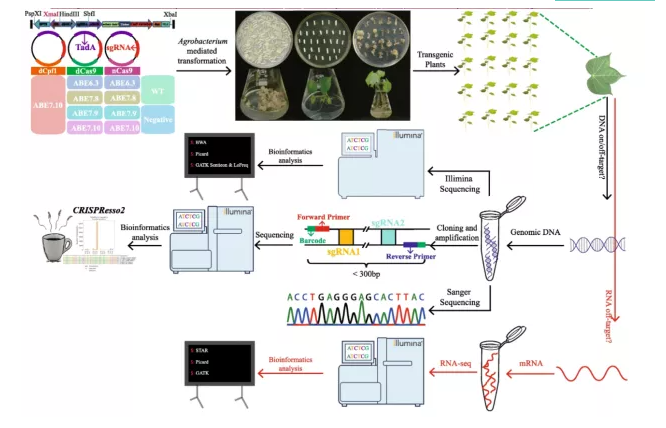Abstract
Blackground
Base editors (BEs) display diverse applications in a variety of plant species such as Arabidopsis, rice, wheat, maize, soybean, and cotton, where they have been used to mediate precise base pair conversions without the collateral generation of undesirable double-stranded breaks (DSB). Studies of single-nucleotide polymorphisms (SNPs) underpinning plant traits are still challenging, particularly in polyploidy species where such SNPs are present in multiple copies, and simultaneous modification of all alleles would be required for functional analysis. Allotetraploid cotton has a number of homoeologous gene pairs located in the A and D sub-genomes with considerable SNPs, and it is desirable to develop adenine base editors (ABEs) for efficient and precise A-to-G single-base editing without DSB in such complex genome.
Result
We established various ABE vectors based on different engineered adenosine deaminase (TadA) proteins fused to Cas9 variants (dCas9, nCas9), enabling efficient A to G editing up to 64% efficiency on-target sites of the allotetraploid cotton genome. Comprehensive analysis showed that GhABE7.10n exhibited the highest editing efficiency, with the main editing sites specifically located at the position A5 (counting the PAM as positions 21–23). Furthermore, DNA and RNA off-target analysis of cotton plants edited with GhABE7.10n and GhABE7.10d by whole genome and whole-transcriptome sequencing revealed no DNA off-target mutations, while very low-level RNA off-target mutations were detected. A new base editor, namely GhABE7.10dCpf1 (7.10TadA + dCpf1), that recognizes a T-rich PAM, was developed for the first time. Targeted A-to-G substitutions generated a single amino acid change in the cotton phosphatidyl ethanolamine-binding protein (GhPEBP), leading to a compact cotton plant architecture, an ideotype for mechanized harvesting of modern cotton production.
Conclusions
Our data illustrate the robustness of adenine base editing in plant species with complex genomes, which provides efficient and precise toolkit for cotton functional genomics and precise molecular breeding

Full text: https://bmcbiol.biomedcentral.com/articles/10.1186/s12915-022-01232-3